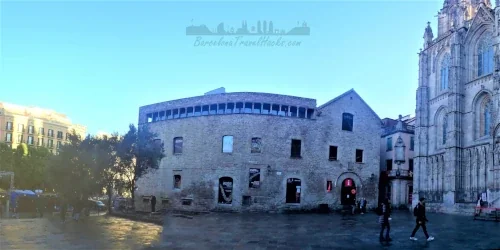Warning: Undefined array key "HTTP_ACCEPT_LANGUAGE" in /home/barcjkkl/public_html/App/Config/MySQL/language.php on line 32
Deprecated: explode(): Passing null to parameter #2 ($string) of type string is deprecated in /home/barcjkkl/public_html/App/Config/MySQL/language.php on line 36
Palau De La Música Catalana - Famous Concert Hall
Art-Nouveau 1908 UNESCO concert hall by Lluís Domènech i Montaner with ceiling skylight. Guided tour tickets or visit for a concert
About Palau De La Música Catalana - Famous Concert Hall
The Palau de la Música Catalana was built from 1905 to 1908 by the modernist architect Lluís Domènech i Montaner as a home for a Catalan Choral Society, the Orfeó Catalá, founded by Lluís Millet i Pagés and Amadeo Vives Roig in 1891. The building is located in the Sant Pere district just above El Born neighbourhood, near plaza Urquinaona.
An Architectural jewel of Catalan Art Nouveau and the only concert venue in this style to be listed as a UNESCO World Heritage Site. The modernist building is designed around a central metal girder structure that allows large glass windows in the auditoruim allowing it to be lit by natural light during the day. This is not typical for a theatre/music hall, which are typically brick and stone structures with no windows in the auditoruim. Palau de la Música exploits many decorative arts such as: sculpture, mosaic, stained glass and ironwork to make for a very vibrant multi colour interior compoared to most theatres with thier red seats and cream interior.
Palau De La Música Catalana History
The building is located on the site of the former monastery of Sant Francesc de Paula. A wrought iron lamp survives from the monastery and is hanging in the Lluís Millet room, Sala Lluís Millet.
The small site and the high price of the adjoining land forced Lluís Domènech i Montaner to fit the auditorium into a tight grid of streets that limited the views of the building from the exterior. Lluís also had to find ingenious solutions to provide sufficient space for the stage and to include the offices and archives of the Orfeó in the building. This was achieved by having the box office, reception main bar and rehearsal space on the ground floor. The auditorium starts from the first floor and spans the height and width of the building.
The church of the former monastery, converted into a parish church, survived until very recently, when it was demolished to provide more space for an extension of the Palau. This project used the space to open a square which shows the huge stained glass windows of the palau de la Música that were previously hidden behind the old church. This has been flanked by two cylindrical brick towers, in imitation of Lluís Domènech i Montaner. Under the large square is the Petit Palau, a new multi-purpose hall with a capacity for 600 people.
Image Gallery for Image Gallery For Palau De La Música Catalana - Famous Concert Hall
Click on any of the 66 images to open full screen gallery player
Visiting Palau De La Música Catalana - Famous Concert Hall
Palau De la Música can be visited as a 50 minute guided tour, self guided tour or by going to see a musical event.
Palau De La Música Guided and Self-guided Tours
The guided tour starts in the reception hall then proceeds to a small rehearsal chamber,
Once the introduction is over the group is left in the Ground floor Café bar area. here you can admire the ornate brick columns decorated with ceramic enamelled flower capitals that lead into the decorative brick arch roof. In the centre of the room is a beautifully carved dark wood bar with stained glass. I recommend waiting till the end of the tour to purchase a drink or snack in this bar.
When the group is called you are led out through some ornate wooden doors onto the main vestibule and grand staircase up to the first floor. The staircase is decorated with bright tiles of a yellow and green hue and up lighting from ornate lamps on the staircase posts which has gold leaf balustrades. On the first floor landing, the Lluís Millet room which faces onto the street via high stained-glass windows with a balcony of more ornate columns decorated with floral mosaics. The brick arches hide the underlying steel frame of the building.
Next you will be led into the auditorium stalls area where you are invited to look up at the magnificent domed stained-glass skylight. You can also see close up the plaster surround of the stage mouth with galloping horses, chariots, shields and crests. Also on the stage is a pipe organ and another skylight. around the perimeter of the semi-circular stage are plaster muses jumping out of the trencadis (mosaic made from broken, irregular shaped tile pieces).This room is a rest area for intermission and contains bronze bust sculptures of all the prominent musical directors that have tenured at Palau de la Música Catalana.
Next you are taken up to the third floor of the building which has the surrounding tiered box seating. You are permitted to walk around the horse shoe shaped seating area and note that every seat has perfect sightlines to the stage. On the fourth floor is another intermission room with a small bar. From here you enter the upper tier of the horse shoe shaped seating area as well as the rear ramped seating area (the rafters) which is also highly decorated with plaster moulds of galloping horses. here you are given an explanation of the acoustics of Palau de la Música. From this level I recommend walking round to the left (when looking at the stage) of the auditorium seating area where you can see out of the stained glass windows.
Finally, the tour is led down a modern staircase in the extension that has glass panelling to allow you to appreciate the ornate brickwork of the outer walls. These stairs take you back to the ground floor bar where you can order a drink and go outside. Here on this patio you will find a large statue of Lluís Millet. when you get outside of the Palau de la Música note the small box office built into the central column of the front façade. Along Carrer de Sant Pere Més Alt, on the corner of Palau de la Música is a modern monument called Carmela by the local artist Jaume Plensa.
Palau De La Música Catalana Opening Times
- Guided tours: 09:00h to 15:00h
- Self Guided tours: 09:00h to 15:30h
Other notable works by Lluís Domènech i Montaner
Lluís Domènech i Montaner was also a prolific Catalan Modernist Architect like Antoni Gaudí wih a lot of his works being industrial buildings. However, he did also create public buildings such as Hospital de Sant Pau (Recinte Modernista) and Castell dels tres dragons - three dragons castle, in Parc Cuitadella
Centenary anniversary of the death of Lluís Domènech i Montaner
2023 is the centenary anniversary of the death of Lluís Domènech i Montaner (b. 30th December 1849, d. 27th December 1923) so expect special exhibitions about this great architect, famous for buildings of public use (Hospital, music hall, Grand restaurant for world fair, factories with good conditions for workers). Most of Gaidí´s works were private commissions for wealthy citizens and religious institutions (grand houses & Basilicas).
Musical events can be found on the calendar section of the website.
What to take with you for What to take with you for Palau De La Música Catalana - Famous Concert Hall
The guided tour is fully accessible for people with disabilities. It is advisable to contact visites@palaumusica.cat
Cloakroom service and left luggage services are not available. so only go with small bags of 10L or less
Bicycle anchorage is in a side street Calle d'Amadeu Vives.
The tour is guided and there is an additional downloadable phone audio guide app so don?t forget headphones.
Tickets for Palau De La Música Catalana - Famous Concert Hall
Getting to Palau De La Música Catalana - Famous Concert Hall
Address: Carrer de Sant Pere Mes Alt 6, Barcelona, 08003
Nearest TMB Metro is Urquinaona on the red (L1) and Yellow (L4) lines. Use a T-Casual or Hola-Barcelona travel card.
Map for Palau De La Música Catalana - Famous Concert Hall
Weather for Palau De La Música Catalana - Famous Concert Hall
Where to stay overnight near Palau De La Música Catalana - Famous Concert Hall
8 Nearby Attractions to Palau De La Música Catalana - Famous Concert Hall
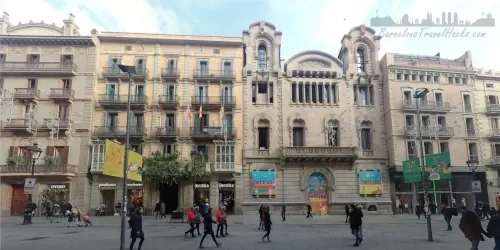
Portal de l'Angel - Barcelona Shopping in historic street
Former monastic land evolved into Barcelona's centrally located, designer brands, shopping street with late opening hours
Read more >
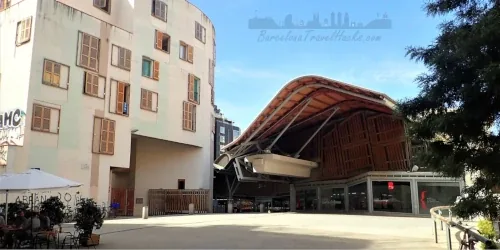
Mercat de Santa Caterina - Santa Caterina Market in El Born
Food market from 1848 with remodelled roof (2005) by Enric Miralles and Benedetta Tagliabue. contains a small display area preserving historic ruins
Read more >
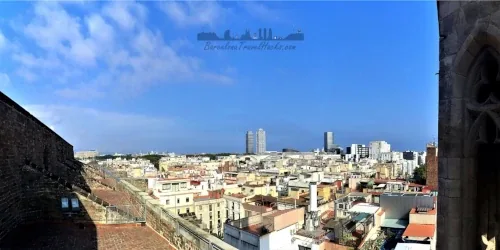
Basílica de Santa María del Mar - Born Cathedral
Gothic cathedral built 1383 at the peek of Catalonia's Maritime and mercantile prominence. Free entry but also offers a guided tour including visit to rooftop
Read more >
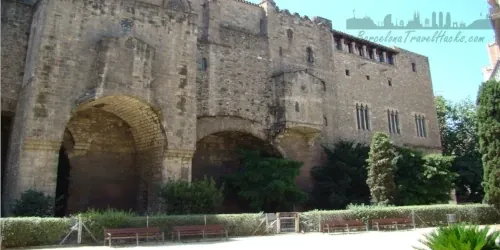
Roman Wall Remains & Plaça Ramon Berenguer III
The remains of the Roman wall run through Plaça Ramon Berenguer III (horse statue) and along Carrer de la Tapineria to Plaza Dels Traginers
Read more >
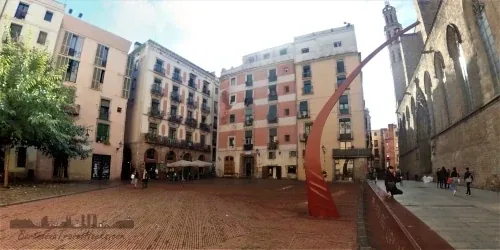
Plaça Del Fossar De Les Moreres Tribute to fallen soldiers
Former Santa María del Mar graveyard and burial site of the fallen from the 1714 siege of Barcelona. Today, a memorial square with eternal flame torch
Read more >
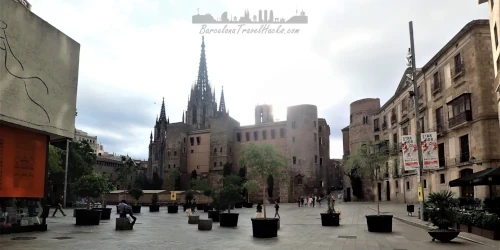
Barcelona's 14th Century Gothic Cathedral
Catedral de la Santa Creu i Santa Eulàlia in the Gothic Quarter. Visitor info, tickets & images from the cloister, cathedral & roof terrace
Read more >
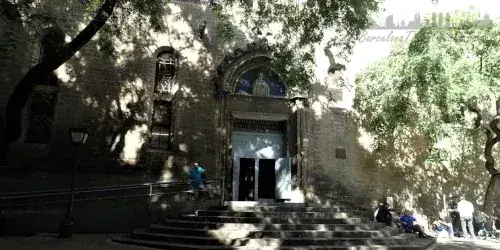
Sant Pere de les Puel·les Church Medieval monastery
10th Century Romanesque Benedictine monastery. What remains today is the 11th century ground floor church with cross floor plan
Read more >
